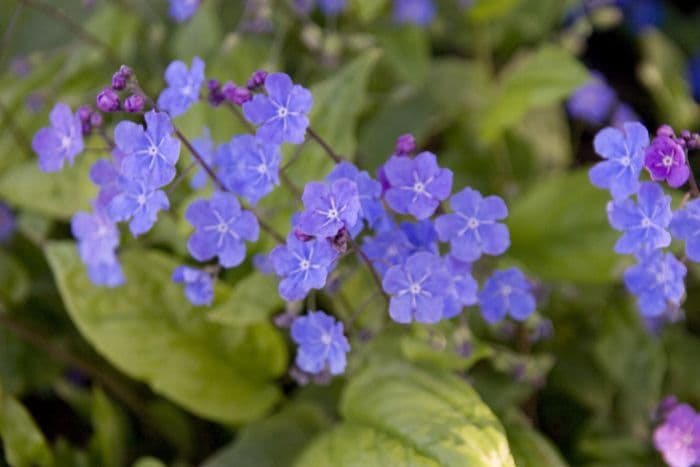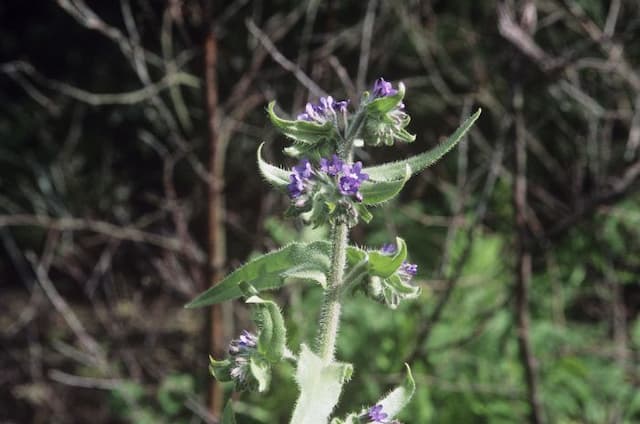Navelwort Omphalodes cappadocica 'Cherry Ingram'

ABOUT
Omphalodes cappadocica 'Cherry Ingram', commonly known as Cappadocian navelwort, is a perennial plant with an eye-catching appearance. It is valued for its striking deep blue flowers, which resemble those of forget-me-nots, with their small, vividly colored petals and white-to-light yellow centers. These blooms appear profusely and create a delightful contrast against the plant's foliage. The foliage of Cappadocian navelwort consists of oval to lance-shaped leaves that are a deep green hue. The leaves are arranged in a low-growing mound and form a dense, lush ground cover that adds rich texture to garden beds throughout the growing season. The plant's leaves and flowering stems have a delicate and airy appearance, which adds to its ornamental value. Cappadocian navelwort's 'Cherry Ingram' cultivar is particularly noted for the beauty of its flowers, which can add a splash of color to shady garden spots. It combines well with other shade-loving plants, contributing to a diverse and layered garden design. The contrast of the deep blue flowers and green foliage creates a lovely visual impact, particularly in the spring and early summer months when the plant is in bloom.
About this plant
 Names
NamesFamily
Boraginaceae.
Synonyms
Cappadocian Navelwort, Cherry Ingram.
Common names
Omphalodes cappadocica 'Cherry Ingram'
 Toxicity
ToxicityTo humans
The Cherry Ingram plant is not commonly known to be toxic to humans. There is limited information on its toxicity, and it is not usually listed among poisonous or harmful plants. Therefore, ingestion of any part of this plant is not typically associated with symptoms of poisoning or other adverse health consequences in humans.
To pets
The Cherry Ingram plant does not have a reputation for being toxic to pets. Just like in humans, there is a lack of information about its toxicity in pets, and it is not generally recognized as a plant that causes harm if ingested. Consequently, there are no specific symptoms of poisoning or adverse effects commonly associated with pets consuming any part of this plant.
 Characteristics
CharacteristicsLife cycle
Perennials
Foliage type
Semi-evergreen
Color of leaves
Green
Flower color
Blue
Height
6 inches (15 cm)
Spread
1 foot (30 cm)
Plant type
Herb
Hardiness zones
4
Native area
Turkey
Benefits
 General Benefits
General Benefits- Ornamental Value: With its vivid blue flowers and attractive foliage, Omphalodes cappadocica 'Cherry Ingram' adds aesthetic appeal to gardens and landscapes.
- Shade Tolerance: This plant is suited for shaded areas in the garden where other plants might not thrive.
- Low Maintenance: It requires minimal upkeep once established, making it ideal for busy gardeners.
- Ground Cover: Its spreading habit makes it excellent for use as ground cover, helping to suppress weeds.
- Seasonal Interest: It provides early spring blossoms, which is often a time when few other plants are in flower.
- Wildlife Attraction: The flowers can attract pollinators like bees, adding to the biodiversity of the garden.
- Drought Resistance: Once established, it can be relatively drought-tolerant, requiring less watering.
- Easy to Propagate: It can be propagated from cuttings or division, allowing gardeners to create more plants at a low cost.
- Minimal Pest and Disease Issues: The plant is generally resistant to pests and diseases, reducing the need for chemical treatments.
 Medical Properties
Medical PropertiesThis plant is not used for medical purposes.
 Air-purifying Qualities
Air-purifying QualitiesThis plant is not specifically known for air purifying qualities.
 Other Uses
Other Uses- Nautical decoration: Omphalodes cappadocica 'Cherry Ingram', commonly known as Navelwort, can be used in sea-themed gardens or as part of nautical decor due to its blue flowers reminiscent of the sea.
- Educational tool: The intricate structure of Navelwort's flowers and leaves can be used for botanical studies and educational purposes to demonstrate plant morphology.
- Photography subject: Due to its striking blue flowers, Navelwort can serve as an ideal subject for nature photography and macro photography workshops.
- Culinary presentation: While not edible, the flowers can be used to accentuate presentation in gourmet dishes, as long as they are removed before consumption.
- Artistic inspiration: The vibrant colors and patterns of Navelwort can inspire artists and be used as reference material for paintings and botanical illustrations.
- Wedding decor: Navelwort can be used as part of wedding decorations, especially for spring weddings, providing a delicate blue accent to bouquets and centerpieces.
- Garden competitions: Gardeners might use Navelwort in creative garden design competitions to showcase its early spring bloom and ground-covering abilities.
- Fairy gardens: This plant, with its diminutive size and charming flowers, is well-suited for creating enchanting fairy gardens, particularly in shady areas.
- Literary device: Navelwort can be referenced in literature and poetry to evoke the imagery of untouched, serene woodland scenes.
- Seasonal festivals: Its early spring flowering can be highlighted during spring festivals or garden tours to celebrate the end of winter.
Interesting Facts
 Feng Shui
Feng ShuiThe Navelwort is not used in Feng Shui practice.
 Zodiac Sign Compitability
Zodiac Sign CompitabilityThe Navelwort is not used in astrology practice.
 Plant Symbolism
Plant Symbolism- Delicacy: With its small, delicate blue flowers, the Omphalodes cappadocica 'Cherry Ingram', commonly known as Navelwort, symbolizes fragility and fineness in the plant world.
- Patience: Navelwort typically blooms early in spring and requires patience as it gradually spreads to form a ground cover, reflecting the trait of waiting for something beautiful to emerge over time.
- Perseverance: The plant’s ability to grow in shady areas and under trees represents the ability to thrive in difficult conditions and the importance of perseverance.
- Hope: The bright blue color of Navelwort's flowers can be symbolic of hope, signifying optimism and the expectation of positive outcomes.
- Memory: Because 'Cherry Ingram' is a named cultivar, it can be indicative of remembrance or paying homage, as cultivars often carry the names of people who were significant in their selection or breeding.
 Water
WaterNavelwort 'Cherry Ingram' should be watered deeply once a week, allowing the soil to dry out slightly between waterings. In hotter, drier climates or during periods of drought, increase the frequency to twice a week. Apply water directly to the base of the plant, avoiding overhead watering to prevent leaf diseases. Each watering session should consist of about 1-1.5 gallons of water, ensuring even soil moisture but avoiding waterlogging. During the winter, reduce watering to every other week as the plant requires less moisture due to cooler temperatures and reduced growth.
 Light
LightNavelwort 'Cherry Ingram' thrives best in partial shade, with morning sun and afternoon shade being ideal. It should be planted in a spot sheltered from harsh midday sun to prevent leaf scorch. A location under dappled light, such as beneath open-branched trees or on the north side of a building, provides the perfect light conditions for this plant to flourish.
 Temperature
TemperatureNavelwort 'Cherry Ingram' prefers moderate temperatures and is hardy in a range between 50°F and 75°F. It can survive minimum temperatures down to around 20°F and should be protected from frost. For optimal growth, aim to keep this plant in an environment where the temperature is consistently within the ideal 50°F to 75°F range.
 Pruning
PruningPruning Navelwort 'Cherry Ingram' is necessary to maintain its shape, encourage bushier growth, and remove any dead or damaged foliage. The best time to prune is in spring, after the risk of frost has passed but before new growth begins. Cut back up to one-third of the plant's size, making clean cuts just above a leaf node. Pruning can be done annually or as needed to keep the plant tidy.
 Cleaning
CleaningAs needed
 Soil
SoilNavelwort 'Cherry Ingram' thrives in well-drained soil with a mix of compost and loam. A pH between 6 and 7.5 is ideal for this plant. For the best soil mix, combine two parts garden soil, one part sand or perlite, and one part compost. This ensures good drainage and nutrient-rich substrate, key conditions for healthy growth.
 Repotting
RepottingNavelwort 'Cherry Ingram' should be repotted every 2-3 years. It's best to repot during the spring season when the plant is entering a period of active growth. Make sure to use fresh potting mix and a pot that is slightly larger than the previous one to allow room for growth.
 Humidity & Misting
Humidity & MistingNavelwort 'Cherry Ingram' prefers moderate humidity levels. It does not require the high humidity of tropical plants but should not be kept in excessively dry environments. Maintaining indoor humidity around 40-50% is generally conducive to healthy growth for this plant.
 Suitable locations
Suitable locationsIndoor
Place Navelwort 'Cherry Ingram' in bright, indirect light, and water when topsoil feels dry.
Outdoor
Plant Navelwort 'Cherry Ingram' in partial shade and moist, well-draining soil.
Hardiness zone
5-9 USDA
 Life cycle
Life cycleThe life cycle of Omphalodes cappadocica 'Cherry Ingram', commonly known as Cappadocian Navelwort or 'Cherry Ingram', begins with germination, where its seeds sprout in spring when soil temperatures are suitable. Following germination, the seedlings establish themselves and grow into juvenile plants, developing a rosette of leaves at ground level. As the plants mature, they develop a sturdy root system and produce distinctive foliage with small, bright blue or violet flowers that bloom in early to mid-spring. After pollination, typically by insects, the flowers produce small nutlets, which are the fruit containing the seeds. These seeds, when mature, are dispersed by various means such as wind or animal movement. The plant then enters a period of dormancy during the colder months, only to repeat this cycle when favorable conditions return in the next growing season.
 Propogation
PropogationPropogation time
Spring-Early Summer
The most popular method of propagation for the Omphalodes cappadocica 'Cherry Ingram', commonly known as Navy Blue, is by division. The ideal time to propagate Navy Blue by division is in the spring or early fall. To propagate, carefully dig up the plant and gently separate the rootball into smaller clumps, making sure each new section has a good amount of roots attached. These divisions should then be immediately replanted in well-preparing soil, at the same depth they were growing previously, and watered thoroughly. This method allows the plants to establish and recover from the division process during the cooler and wetter months, ensuring a better success rate for the newly created plants.









